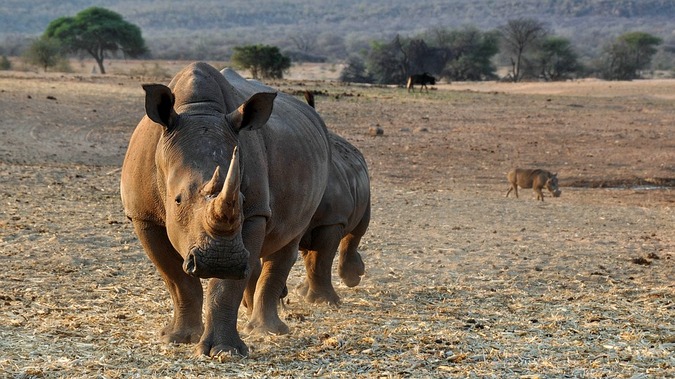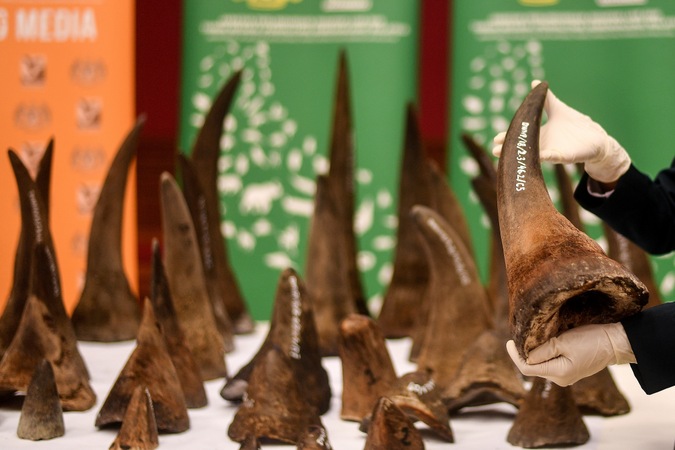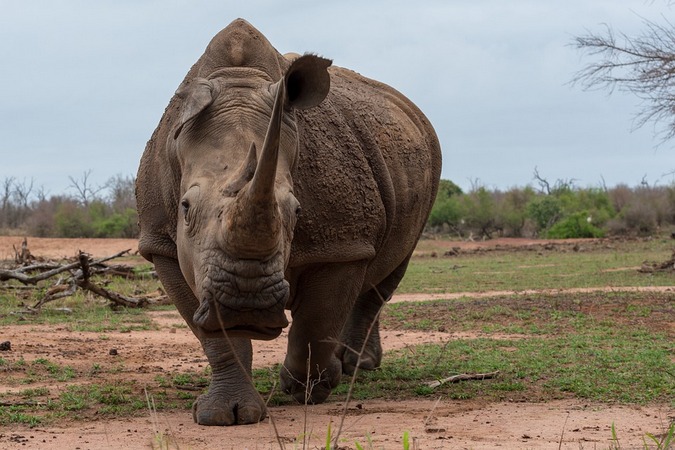
The Secretariat of the Convention on International Trade in Endangered Species of Wild Fauna and Flora (CITES) has revealed the proposed changes in CITES trade rules that, along with a range of other policy and implementation issues, will be discussed at the forthcoming Conference of the Parties taking place next May in Sri Lanka (CoP18).
Of the 57 proposals to amend the lists of species, two relate to the white rhino, where both Namibia and Eswatini (formerly Swaziland) have requested changes to their rhino population Appendix listing.
Namibia has proposed to change the CITES status of their white rhino population from Appendix I to Appendix II , which would allow international trade in live animals and in trophy hunting trophies. Eswatini has proposed the removal of the existing annotation on the Appendix II listing of its white rhino population, which would allow international trade in rhinos and their products – including horn and derivatives.
The CITES CoP meetings occur roughly every three years and changes to trade rules, through amendments to the Convention’s Appendices, can have profound conservation implications for affected species.
The listing of a species in Appendix I includes species threatened with extinction, and effectively prevents all commercial international trade, while those species listed in Appendix II are not necessarily threatened with extinction and can be traded under special permit conditions.

Namibia
Namibia’s proposal is asking for CITES to change the status of their white rhino population from Appendix I to Appendix II. This change, according to their proposal, would allow the international trade in “live animals to appropriate and acceptable destinations”, and legally hunted trophies.
The majority of white rhinos in Namibia are privately owned, with large numbers imported from South Africa since 2012. The Ministry of Environment and Tourism is responsible for monitoring white rhinos in Namibia, and those in the private sector are monitored through the State permitting system where private owners only receive transport or hunting permits if the relevant individuals have been microchipped and DNA profiled.
The proposal notes the following rationale behind the request to change to Appendix II:
1) Namibia has an increasing population of white rhinos – the second largest population in the world after South Africa – currently standing at 1,037 based on surveys during the 2017-2018 period. The current privately-owned population comprises of 780 animals in around 70 populations. The State-owned population in 2018 comprises of 267 animals in three protected areas. According to the proposal, the rhino population is secure, with a steady growth rate of 6.7% per annum noted between 2002-2018 (including imports from South Africa). There has been no impact to the growth rate with the current low levels of exports of hunting trophies and live animals.
With this said, the population does not meet the criteria for inclusion in Appendix I as it is a) not small; b) not declining; c) does not have a restricted distribution as there are multiple subpopulations throughout the country; and d) there has been no marked decline in the population for 43 years since the re-establishment of the population in Namibia.
2) The transfer will, according to the proposal, not threaten the survival of the species as there are already the necessary control and enforcement measures in place, which have shown to be relatively successful in curbing illegal killing and illegal trade. Trade in live animals will only take place to appropriate and acceptable destinations, therefore allowing Namibia to verify the destination. With the transfer to Appendix II, Namibia will be able to export live animals and hunting trophies to more countries and will increase revenue through sustainable use, and therefore generate much-needed funding for rhino conservation and protection.
It should be noted that with the rhinos currently under Appendix I, Namibia’s ability to generate revenues for conservation has been severely limited. Transferring the population to Appendix II will create access to a far larger market for the animals.
3) Benefits of the transfer would include a) motivating Namibian rhino owners to effectively manage their populations, investing and protecting them as sustainable, utilisable and economic assets; b) the revenue from rhino sales would go directly into conservation, anti-poaching programmes, and habitat management, and c) the reduction in the rhino population, through the increased trade in live animals and trophy hunting, will allow more habitat to become available to breeding rhinos and therefore an increase of their reproduction rates.
The proposal concludes with the following:
“Namibia fully supports every effort at all levels to stamp out the illegal trade in rhinoceros products and has pledged its full cooperation with all involved in such actions. At the international level, Namibia has made strenuous efforts to stop illegal trade and has been successful in reducing illegal killing by half in the last two years in Namibia. This proposal, therefore, is simply a down-listing proposal, with no consequential actions being implemented other than to facilitate the trade in live animals to appropriate and acceptable destinations, and legally hunted trophies which in turn will enhance the conservation of the species and its habitat.”

Eswatini (formerly Swaziland)
Eswatini’s proposal is to allow unrestricted international commercial trade in all specimens of its white rhino population, which is currently included in Appendix II.
Currently, there are two areas where white rhinos are found in Eswatini: Hlane Royal National Park and Mkhaya Game Reserve. Together there is a total population of 66 white rhino, this is after a three-year drought severely affected the population which stood at 90 animals in 2015. According to the proposal, there are plans to place white rhinos in Mlilwane Wildlife Sanctuary in the future.
All three parks rely on self-generated revenues, and are under heavy strain to support the wildlife, including rhinos, after the recent surge in costs ─ particularly with escalating security requirements to protect wildlife from poachers.
The proposal to CITES is to allow Eswatini to sell rhino horn from existing stock to licensed retailers in the Far East, plus up to 20 kg per annum, including harvested horn, to those retailers. The proposal states that the proceeds from the sale of existing stocks should raise approximately US$9.9 million if sold at a wholesale price of US $30,000 per kg. That amount will be placed in a conservation endowment fund to yield approximately US$600,000 per annum.
In addition, the proceeds of the annual sale of up to 20 kg of horn will raise a further US $600,000 per annum, bringing total recurrent annual income from horn to US $1.2 million. The annual sales of 20 kg can be sourced from sustainable non-lethal harvesting of horn.
There is no trophy hunting of white rhino in Eswatini as the rhinos live in Big Game Parks reserves where sport and trophy hunting is not permitted. Legal white rhino horn is kept in stockpiles in various places of safe-keeping within the country – though this presents an enormous risk and an attraction to criminals; strongrooms and museums have been raided elsewhere by these criminals.
This horn has been legally collected from natural deaths, horn knock-offs and legitimate management actions (including dehorning and horn-tipping for translocation) of white rhino over many years, or has been recovered from illegally hunted rhinos.
“Eswatini does not believe in burning or otherwise destroying valuable resources including rhino horn, when conservation agencies across the continent are under-funded and cash-strapped,” the proposal states. “Eswatini also sees no sense in devaluing its natural resources when they can and should become an added value for the benefit of successful conservation and rhino range states at large.”
The proposal lists the benefits of the proposed change:
1) Proceeds from the sale of horn will be utilised by Eswatini’s rhino parks in order to protect the country’s rhino populations against criminal poaching syndicates.
2) Horn sales will allow the remuneration of park employees to be improved.
3) Proceeds will be used to fund much-needed additional infrastructure and equipment, range expansion and to cover supplementary food during periods of drought.
4) Proceeds will also be used to provide for sustainable long-term developments, all of which will strengthen species protection and other nature conservation initiatives, while also benefiting neighbouring rural communities and the nation at large.
“The CITES ban on trade in rhino horn has been in force for 42 years and it is clearly not working – rhino losses from illegal hunters are driving rhinos towards extinction,” the proposal states. “At present 100% of the proceeds from the sale of rhino horn are taken by criminals, while rhino custodians pay 100% of the costs of rhino protection and production without the funding that could cover these costs from legal trade. Opening legal trade would immediately rectify this inequity and open competition to the illegal trade. Whatever income the legal trade attracts will be unavailable to the illegal trade, reducing illicit profits and strengthening protection.”
To comment on this story: Login (or sign up) to our app here - it's a troll-free safe place 🙂.![]()






